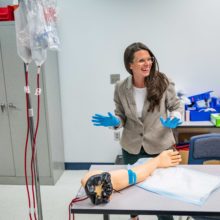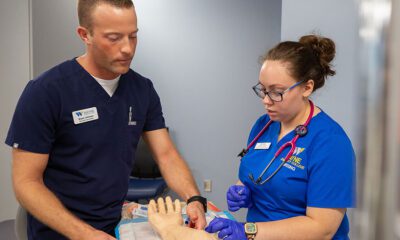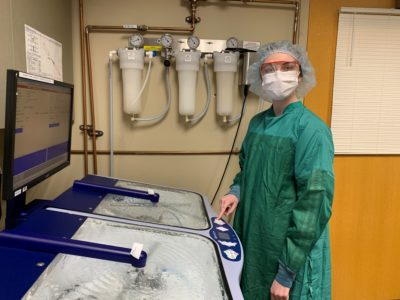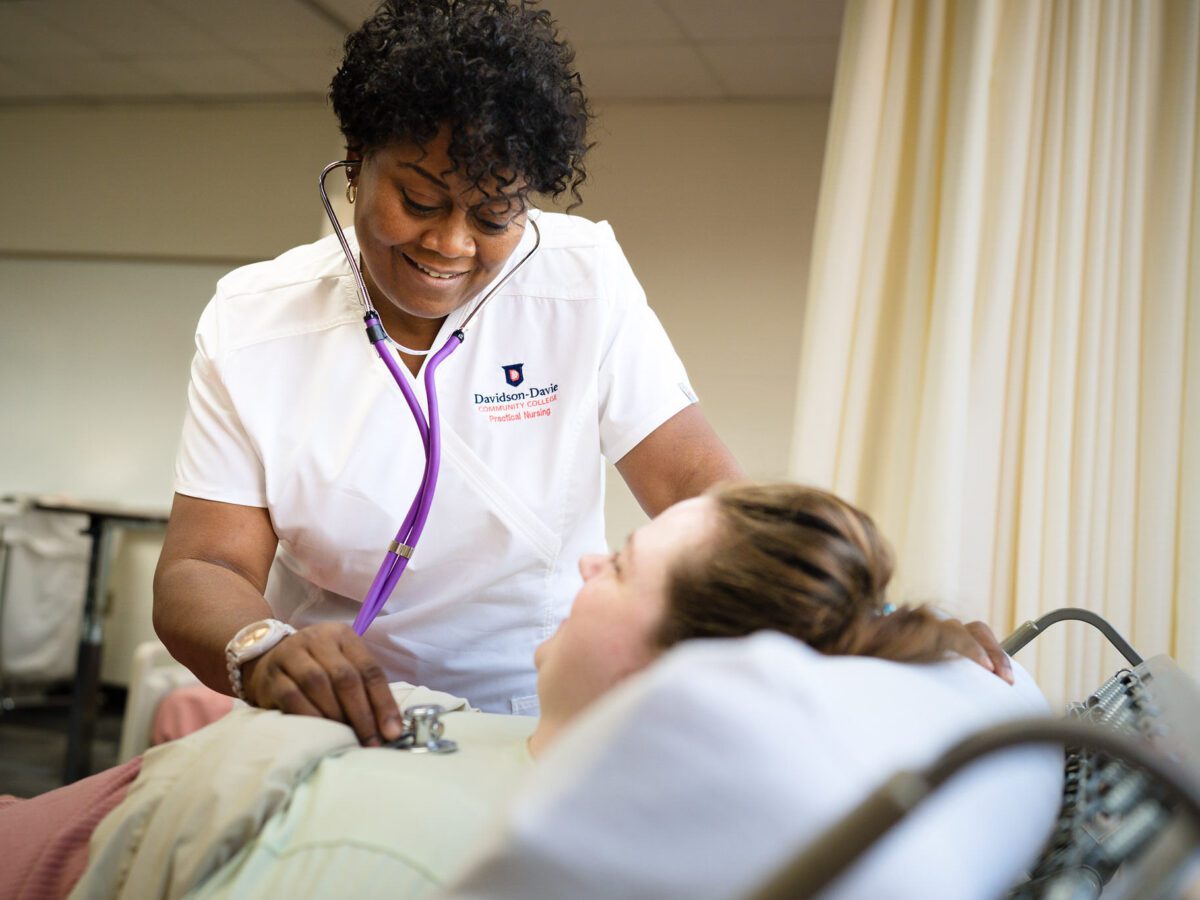

|
|
Contents
- Introduction
- Providing quality health care and meeting the workforce demand
- The apprenticeship model as a path forward
- A look at Davidson and Davie counties
- Launching a nursing apprenticeship program
- Results
- Benefits
- Key elements of the nursing apprenticeship model
- Key stakeholders
- Funding
- Lessons learned
- Recommendations
- Appendices
Introduction
Even before the pandemic, the demand for nurses in North Carolina was on the rise, and experts predict North Carolina will see nursing shortages over the next decade. By 2033, the state could face a shortage of roughly 12,500 registered nurses (RNs) and over 5,000 licensed practical nurses (LPNs).
Hospitals are projected to undergo the largest shortage of RNs, followed by nursing homes, extended care, and assisted living facilities. Similarly, nursing homes, extended care, and assisted living facilities could see upwards of a 50% loss of LPNs and hospitals as much as 31.7% by 2033.
As leaders across the state discuss the looming health care shortages facing North Carolina, one community college is piloting a way to address the shortage.
In 2020, Davidson-Davie Community College (Davidson-Davie) and Atrium Health Wake Forest Baptist launched the first registered nursing apprenticeship program for adults in response to their community’s nursing shortage. The apprenticeship program is based on the “earn and learn model” where participants earn a paycheck while they’re being trained for the job. Through the apprenticeship, students enrolled in the college’s associate degree nursing (ADN) program work in the health care industry while simultaneously being prepared academically to pass the National Council Licensure Examination for Registered Nurses (NCLEX-RN).
The following case study explores:
- Quality health care and the workforce demand
- The apprenticeship model
- Assessing community health care needs in Davidson and Davie counties
- Launching a nursing apprenticeship program in North Carolina
- Results
- Benefits
- Key elements of the nursing apprenticeship model
- Funding
- Lessons learned
- Recommendations
- Appendices
Providing quality health care and meeting the workforce demand
America is one of the wealthiest countries, yet is among the sickest compared to other high-income countries. Even before the pandemic, the United States was 29th out of the 39 member nations of the Organization for Economic Cooperation and Development. In 2023, life expectancy declined to 76.4 years – the shortest it’s been in almost 20 years.
Some of the sicker populations in the country tend to be those living in rural areas. The NC Rural Center considers 78 of North Carolina’s 100 counties rural. These counties are home to 40% of the state’s population, making North Carolina’s rural population the second largest in the country behind Texas.
The country isn’t just sicker, it’s also losing a significant portion of its workforce, and many communities, particularly in rural areas, are feeling the brunt of the great resignation and population declines.
Communities in North Carolina are challenged with not only providing quality health care but also supplying the health care workforce.
According to the U.S. Department of Labor, “Employment in health care is projected to grow faster than the average for all occupations through 2032 with 1.8 million openings per year.”
But the growing demand is quickly outpacing the ability to fill positions due to talent shortages, burnout among health care workers, and increasing skill demands.
One way communities are problem solving is by aligning postsecondary education and industry, and the North Carolina Community College System (NCCCS) is leading the way.
North Carolina’s community college system was designed to provide accessible postsecondary education to all students regardless of prior educational experience. The state’s 58 community colleges are located within a 30-minute drive for any North Carolinian.
North Carolina community colleges are economic drivers for the state, helping fill the talent pipeline with skilled individuals. Part of filling the talent pipeline is addressing the needs of the community, and for most counties, that need is more health care professionals, specifically nurses.
According to Dr. Holly Myers, dean of health sciences at Davidson-Davie, the NCCCS produced 52% of the state’s RNs in 2022. While this has helped mitigate the nursing shortage, it hasn’t been enough to ease the strain on health care systems.
“We can’t get out of this deficit that we’re in by doing the same thing over and over again.”
Dr. Holly Myers, dean of health sciences at Davidson-Davie Community College
At the height of the pandemic, travel nurses were being used to mitigate shortages. But this was a temporary solution — not meant to solve the issues at hand.
Leaders from Davidson-Davie Community College and the health care system in Davidson and Davie counties put their heads together to breathe life into a program that would help address the nursing shortages, and in 2020, Davidson-Davie and Atrium Health Wake Forest Baptist launched their registered nursing apprenticeship program.
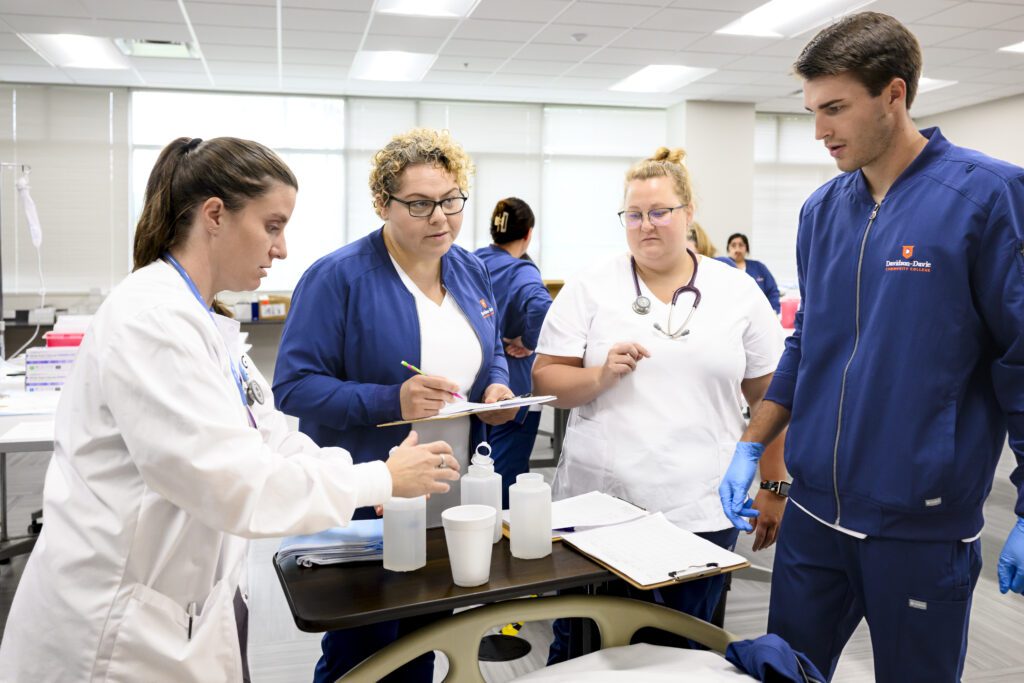

The apprenticeship model as a path forward
Apprenticeships are nothing new – centuries old in fact. But the “earn while you learn” model is making a comeback, gaining support at the federal and state level.
Between 2015 and 2022, the U.S. Department of Labor (DOL) distributed more than $1 billion in apprenticeship grants to state workforce agencies and intermediaries. According to the DOL, evidence supports the benefits of apprenticeships not only for employers but for workers and society as a whole.
For employers, the return on investment includes reduced cost of hiring as well as employee loyalty. Workers who participate in apprenticeship programs often see higher earnings. Higher earnings and credential attainment (or skilled training) can be directly linked to a healthier society. Studies show that postsecondary attainment is a pathway to economic opportunity. And while earning a credential helps move families economically, it is also linked to better physical and mental health, relationships, and civic engagement.
In its 2021 biennium budget, the North Carolina General Assembly included $12 million to expand apprenticeships in the state to individuals ages 16 to 25. The funding supports 50 of the system’s 58 community colleges serving Tier 1 and Tier 2 counties and small businesses (no more than 500 employees) working with one of the 50 eligible community colleges.
Employers receive up to $2,000 per apprentice for onboarding and training and a 50% salary reimbursement on wages up to $15 per hour for non-high school students and $14 per hour for high school students. Colleges receive up to $2,500 per apprentice for tuition, books, fees, and supplies. These funds are available through Dec. 21, 2024 until expended.
Additionally, the DOL provided the North Carolina Community College System a $4 million grant to strengthen ApprenticeshipNC. The system gained control of the state’s apprenticeship programs from the Commerce Department in 2017.
As of Dec. 2023, ApprenticeshipNC has over 9,100 active apprentices and nearly 1,400 active registered apprenticeship programs across the state. Presently, the state has over 400 health care apprentices and approximately 80 nursing specific apprenticeship programs. Those numbers fluctuate as ApprenticeshipNC adds occupations and apprentices daily.
In North Carolina, nine industries are represented in the apprenticeship program model: advanced manufacturing, construction, energy, finance, health care, hospitality, information technology, logistics, and public safety.
Youth apprentices are characterized as individuals ages 16 to 24 who are eligible under the Workforce Innovation and Opportunity Act (WIOA) for training and employment services. Most often, youth apprentices are under the age of 18 and have not yet graduated high school. In many industries, the term youth apprentice and pre-apprentice are used interchangeably.
A look at Davidson and Davie counties
Davidson-Davie Community College serves two counties, Davidson and Davie. While the two areas have distinct education and health needs, both counties have felt the strain of nursing shortages, particularly during the pandemic.
Davidson County is a suburban area with a population of 172,586. As of 2022, 12.5% of Davidson County’s population is below the poverty level.
Davie County is predominantly rural with approximately 70% of the population residing in rural areas. As of 2022, Davie County’s population is 44,090. According to the U.S. Census Bureau, 11.4% of the county’s population falls below the poverty level.
Lexington Medical Center (Davidson County) and Davie Medical Center (Davie County) are two facilities within the Atrium Health Wake Forest Baptist system, and both are host sites for the nursing apprenticeship program. Lexington Medical Center is a not-for-profit community hospital operating 94 acute-care beds and is a satellite provider for several specialty services within Atrium Health Wake Forest Baptist. Davie Medical Center is a not-for-profit hospital facility located in Bermuda Run. The facility is a 50-bed inpatient hospital with a 24/7 emergency department and includes a host of clinical services throughout their medical plazas.
In recent community health needs assessments, Atrium Health Wake Forest Baptist highlighted the most significant health needs of Davidson and Davie counties, including the opioid epidemic, mental health, and obesity. In 2019, cancer and heart disease were the leading cause of death in both counties.
The rising health care needs of community members continue to strain the health care system. Simply put, there are not enough trained workers to handle the surge in facility use, particularly when it comes to nursing staff.
Launching a nursing apprenticeship program
Davidson-Davie and Atrium Health Wake Forest Baptist knew that launching a nursing apprenticeship program could help with staffing shortages, but they also knew they needed to start small and scale the program.
Since apprenticeships have traditionally operated within a manufacturing model, the college and health care systems had to get strategic due to the many compliance requirements involving health care professionals as regulated by the North Carolina Board of Nursing.
“We are used to apprenticeships in the manufacturing world. We’re good at that. But this was new for a lot of people, and it makes really obvious sense to them when they hear about it. You know, why wouldn’t we take this model and apply it to health care, just like we were used to seeing in other fields. And I think people will continue to see how much sense this makes across the board.”
Jenny Varner, president of Davidson-Davie Community College
Results
As of fall 2023, the program has admitted 11 apprentices. Of those, five have now graduated as RNs, three did not complete the program, and three are currently completing their apprenticeships.
Of the five who graduated, four are employed in the Atrium Health Wake Forest Baptist system and one is employed at Novant. The program expects to enroll seven apprentices in fall 2024. Apprenticeship admittance is based on open positions at Lexington Medical Center and Davie Medical Center.
Benefits
Perhaps one of the most important aspects of an apprenticeship model is that it benefits all involved – students, employers, academic institutions, and the community.
Students
Apprentices are getting hands-on experience that non-apprentices are not. While clinical rotations in nursing school provide students with some experience, they do not compare to the on-the-job training apprentices receive. Students said the apprenticeship is beneficial for several reasons, but mostly because it helps prepare them for the moment they become a registered nurse. Plus, it’s a good salary, particularly at a time with rising costs across the board.
“It’s not Grey’s Anatomy.”
Casey Castrianni, graduate of the inaugural nursing apprenticeship cohort
The apprenticeship also gives students the chance to accelerate the RN program from 36 months to 24 months. Non-apprentices must obtain 3,328 hours of LPN-specific work to be eligible to enroll in the LPN to ADN program. Apprentices are exempt from this requirement due to the on-the-job training and mentor-based work relationship.
In a typical setting, non-apprentice LPNs work approximately 40 hours per week for 81 weeks in order to obtain the required hours. Since apprentices are mentored and work on medical-surgical floors encountering a variety of scenarios, Davidson-Davie found their experience to be a sufficient replacement for the 3,328 required hours.
Employers
Retaining students is a win for employers. The apprenticeship model cultivates loyalty and trust between the student and employer.
“It’s building that loyalty with the employer.”
Dr. Kimberly Stanbery, chief nursing officer, Comprehensive Cancer Center, Atrium Health Wake Forest Baptist
At a time when rural populations are seeing significant population declines, the apprenticeship model is also helping grow local health care professionals, limiting the reliance on travel nurses and allowing students to remain in the communities where they have established roots.
Academic institutions
College leaders acknowledge nursing apprenticeships have led to widespread interest in the program across the state and country. Students are interested, and other academic institutions have asked Davidson-Davie how to incorporate a similar model in their communities.
“I think we have helped people see a new side to apprenticeships that they never considered, especially in an area like this that was built on traditional manufacturing.”
Jenny Varner, president of Davidson-Davie Community College
Community
It’s a win for the community because not only is it generating a more stable health care infrastructure, it’s also creating a health care system of professionals who are living where they work.
“It’s a workforce that looks like the community they are serving.”
Dr. Susan Burleson, executive vice president, academic and student affairs, Davidson-Davie Community College
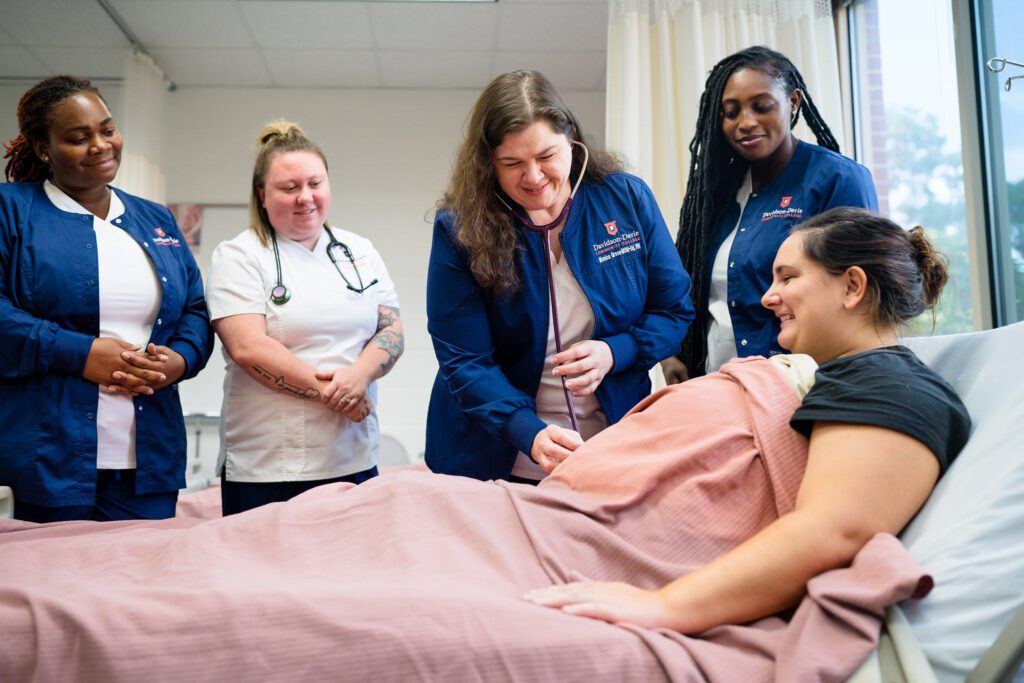

Key elements of the nursing apprenticeship model
Structure of the program
Those interested in the nursing apprenticeship program must first apply and be admitted into the college’s nursing program through the traditional college process. Davidson-Davie uses a holistic admissions process, awarding points to students for their strong academic and professional work backgrounds in addition to standardized testing.
Once admitted to the nursing program, there are two pathways to become an apprentice. The first is the Licensed Practical Nursing (LPN) to associate degree in nursing (ADN) pathway. The second is the nurse aide to associate degree in nursing (ADN) pathway. When students complete their associate degree in nursing, they take the National Council Licensure Examination for Registered Nurses (NCLEX-RN) to become a certified registered nurse.
LPN to ADN pathway
Atrium opens the apprenticeship application to students enrolled in the college’s LPN program during their last semester – shortly before students take the National Council Licensure Examination for Practical Nurses (NCLEX-PN). Atrium conducts interviews and hires the number of students needed to fill current vacant positions. The LPNs are hired as apprentices on the medical-surgical floors at Davie and Lexington Medical Centers and work full-time from September through mid-August the following year. Both Davidson-Davie and Atrium found that medical-surgical floors provide the most hands-on experiences for apprentices.
On-the-job training is a key component of the apprenticeship. For LPNs, this training can include: record patient medical histories, monitor patient conditions, maintain medical facility records, inform medical professionals regarding patient conditions, collaborate with health care professionals to plan or provide treatment, manage health care operations, and advise medical personnel regarding health care issues. Apprentices can complete the required on-the-job training skills any time before, during, or after their credentialing to become a registered nurse.
After the first year of full-time work as apprentices, the LPNs begin their LPN to ADN transition courses at Davidson-Davie in August and shift to working part-time on their respective floors/units.
Each nursing student is required to complete clinical hours as a component of their ADN training. Clinical hours are required by the NCCCS and the Board of Nursing. Apprentices do not count the hours they work as apprentices toward their clinical hours.
Apprentices are able to schedule their work around their class and clinical hours, so they have the same class schedule as non-apprentice ADN students.
Nurse aide to ADN pathway
Similar to the LPN to ADN model, students enrolled in the college’s entry-level nursing course (NUR 111) are presented with the apprenticeship application toward the end of the course. Atrium conducts interviews and hires those students as nurse aides on the medical-surgical floors.
Students work as full-time nurse aides on their respective floors after the successful completion of their entry-level nursing course. Similar to the LPN to ADN model, once students begin taking courses towards their ADN, they can move to part-time hours as nurse aides.
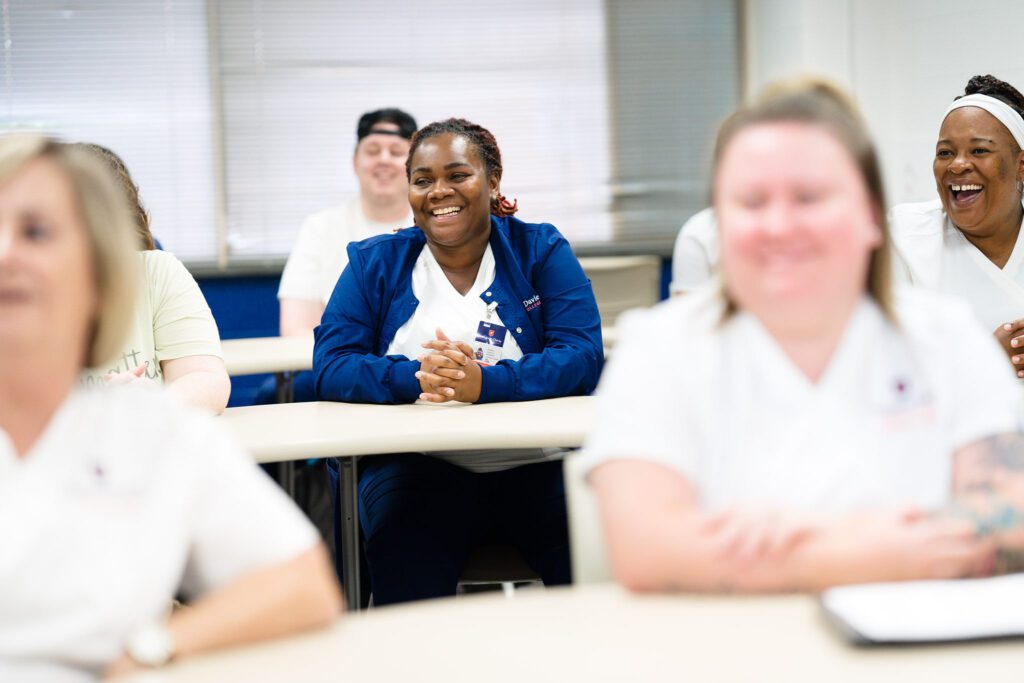

Key stakeholders
Registered apprenticeships in North Carolina require a sponsor. Often employers are the sponsors and are responsible for the administrative tasks, including registration of the program through ApprenticeshipNC. Recently, however, more community colleges have taken on the sponsor role, working in tandem with employers to develop and integrate an apprenticeship model.
For this model, Davidson-Davie is the sponsor, which means the college handles the administrative tasks and provides the academic instruction while Atrium Health Wake Forest Baptist hires and pays the apprentices, provides on-the-job training, and supplies mentors.
ApprenticeshipNC requires that every apprentice be assigned a mentor who ensures on-the-job training but can also serve as peer support for the apprentice.
Key stakeholders and their roles include:
- Davidson-Davie Community College
- Senior administration: Responsible for vision building, ongoing partnership communication, and community relationship building.
- Health science dean: Lead point person to carry out program details, administrative tasks, and inform senior administration of changes.
- Nursing faculty: Provide academic instruction and advising to apprentices. Key support system for students.
- Atrium Health Wake Forest Baptist
- Hospital administration and human resources: Responsible for vision building and ongoing communication to revamp work culture with regards to how apprentices are paid and integrated into the hospital system.
- Nursing managers: Responsible for overseeing skills training, integrating apprentices on their units, and ensuring on-the-job training is being implemented.
- Mentors: One-to-one peer mentors for apprentices. Key support person for students.
- ApprenticeshipNC: Responsible for approving all apprenticeship programs and supporting the development of those programs in the state of North Carolina. Regional consultants provide sponsors with pertinent information related to apprenticeship registration and program development.
- Board of Nursing: College leaders involved North Carolina’s Board of Nursing to ensure compliance standards were being met during the development of the nursing apprenticeship program. Davidson-Davie discussed the apprenticeship program with their Board of Nursing educational consultant to allay any concerns with interpretations of nursing laws and regulations.


Funding
Atrium Health Wake Forest Baptist is responsible for paying apprentices’ salaries. Once participants enter their senior year of the ADN program, they qualify for a wage increase.
In some apprenticeship models, apprentices are paid for time spent in class in addition to at work. This model, however, pays apprentices only for their hours worked.
In addition to paying apprentices’ salaries, employers can also provide tuition reimbursements and stipends to apprentices. Currently, Atrium Health Wake Forest Baptist pays apprentices the following stipends based on experience and skills gained.
Nurse Aide to ADN pathway:
- $2,500 at 3 months
- $2,500 at 12 months
- $2,500 at 24 months
- $2,500 at 36 months
- $5,000 at 48 months
LPN to ADN pathway:
- $2,500 at 4 months upon validation of clinical competency and completion of all educational offerings as indicated by RN Mentor
- $2,500 at 12 months
- $5,000 at 24 months upon completion of apprenticeship program
The hospital also pays the required mentors an additional $1 per hour.
Students who do not receive tuition reimbursement from their employer may still be eligible to receive funds through federal and state scholarship and aid programs. Additional financial requirements are paid out of pocket by students or the college if funding is available.
Upon passing the NCLEX-RN exam, participants will receive entry-level wages consistent with all new graduate registered nurses.
Atrium Health Wake Forest Baptist does not currently receive federal or state funding to offset the apprenticeship costs due to funding regulations
The United States Department of Labor’s $4 million grant disbursed to ApprenticeshipNC provides funds for apprenticeships, but only to employers with less than 5,000 employees. For most health care systems, their size automatically disqualifies them from accessing these funds.
Similarly, state funding approved in 2021 to expand apprenticeships is limited to small businesses (less than 500 employees) in Tier 1 and Tier 2 counties and is only available to apprentices who are between the ages of 16 – 25.
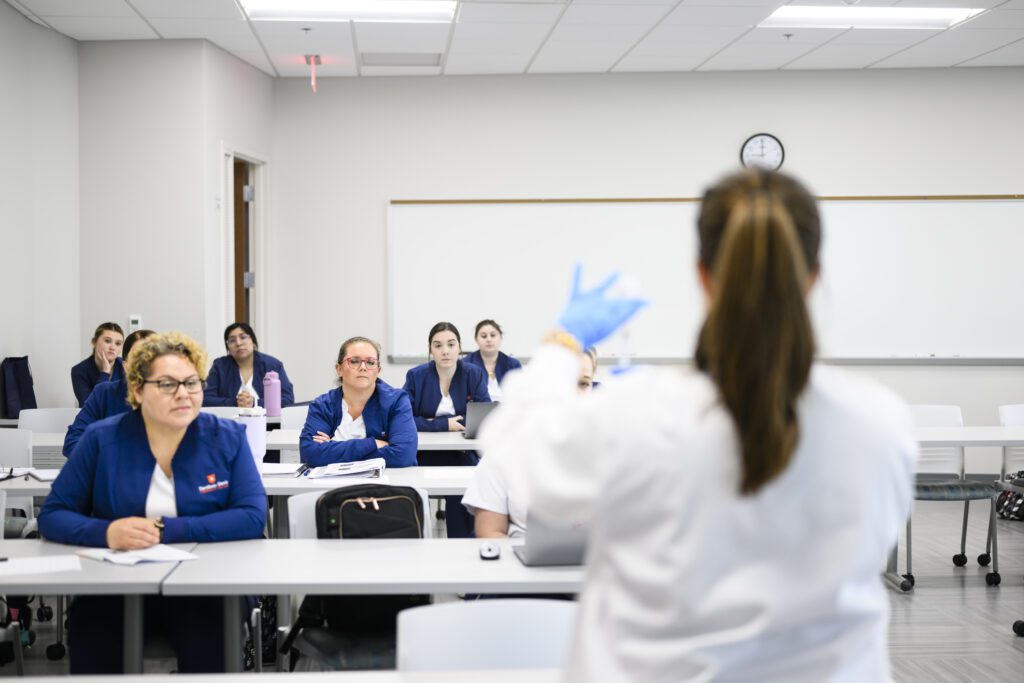

Lessons learned
Since 2020, Davidson-Davie and Atrium Health Wake Forest Baptist continue to learn what it takes to implement and iterate a nursing apprenticeship program. Outlined below are key takeaways obtained from interviews with faculty and staff at Davidson-Davie Community College, current and former apprentices, and leaders from Atrium Health Wake Forest Baptist.
The importance of relationships and collaboration
The needs of the community cannot be solved without community partnerships. Academic institutions and health care systems must work together to address the health care concerns of their communities.
What started as a conversation about the growing need for more nurses quickly turned into a collaborative effort between leaders at Davidson-Davie, Davie Medical Center, and Lexington Medical Center.
“I think that relationship is so imperative and ensures that our future workforce is prepared. Our workforce is being developed in a way and changed in a way that actually suits the ever-changing needs of our patient populations.”
Marlee McConnell, Clinical Nurse Educator, Davie Medical Center.
“I think one of the benefits coming out of this is, again, that much stronger relationship with the academic institutions and how we work together to help solve this problem.”
Dr. Kimberly Stanbery, chief nursing officer, Comprehensive Cancer Center, Atrium Health Wake Forest Baptist
College as the sponsor
Launching a registered apprenticeship program requires significant paperwork and can be confusing for those not familiar with the process. Leaders at both Davidson-Davie and Atrium Health Wake Forest Baptist noted the difficulty of interpreting some of the language from the U.S. Department of Labor with regards to registering to be a sponsor of an apprenticeship program.
To alleviate some of this, the college opted to serve as the sponsor and the dean of health sciences, Dr. Holly Myers, took on the role of carrying out the administrative tasks associated with being the program sponsor.
Since the launch of this program, Davidson-Davie has collaborated with other academic institutions, helping leaders navigate the paperwork.
Shifting mindsets and rethinking policies
Leaders from Atrium Health Wake Forest Baptist said implementing the nursing apprenticeship model meant they had to rethink how they hired and trained individuals.
This required leaders from the top down to be on board and be willing to make necessary changes. These changes included adjusting their human resources framework, how many hours apprentices would be required to work, and how they awarded educational stipends.
As for Davidson-Davie, the college had already begun to rethink how they admitted students to their nursing program. In previous years, the college followed a more rigid formula for entrance where tests were given more weight. Now, the college takes a more holistic approach and incorporates multiple measures, which include prior work experience and previous academic GPAs.
Perhaps one of the biggest shifts in mindset is understanding the needs of apprentices. Since this is an adult apprenticeship, many students enter the program juggling family, work, and school. The recognition that apprentices are people first with full lives can help strengthen the program, create loyalty, and retain students once they complete their degree.
Identify a point person and liaison between college and health care partner
While collaboration is crucial, implementing a nursing apprenticeship program requires a point person to lead the efforts, especially if the college is the sponsor. The point person is responsible for helping to register the apprenticeship with ApprenticeshipNC and handling the related administrative duties.
In this instance, the dean of health sciences at Davidson-Davie became the point person.
“In my experience, it needs to be someone who knows those programs in those disciplines.”
Dr. Holly Meyers, dean of health sciences at Davidson-Davie
What has emerged since the program’s inception is that in addition to a point person, the program needs a dedicated liaison who can work between the hospital system and the academic institution.
One challenge both entities shared was keeping track of students’ progress during the transition time before students begin nursing school and while they are serving as apprentices. This is where leaders say the liaison could be beneficial to chart progress and communicate between the employer and institution.
Over communicate
Over communicating is imperative. As leaders reflected on implementation, they noted how critical communication is at all levels.
All parties must understand the critical details of the program and how it will impact their line of work.
When implementing, the institution needs to make those in academic advising and enrollment aware of the options available to students with regards to apprenticeships. As for the hospital, leaders say involving nursing managers is critical to ensure the program is effectively implemented and carried out.
After the program launch, both the hospital and institution say ongoing communication is important to keep students on track with both work and academics. As noted above, this is an area where a liaison could serve as the main point of contact for apprentices.
Importance of iterating the model
Hospital and academic leaders understand that a program’s success largely depends on the ability to iterate and make changes when needed.
Since 2020, the nursing apprenticeship program has already gone through one major change. When it first launched, apprentices were expected to work full-time while enrolled in an ADN program full-time. Since the same academic rigor and clinical hours are required for apprentices as for non-apprentices, both the hospital and institution realized they needed to change the work requirement to mitigate the challenges of nursing school. Now, students transition to working part-time hours once they begin their ADN courses.
It’s more than nursing shortages
While the state’s need for nurses is reaching critical levels, leaders recognize that strengthening the health care system extends beyond getting more registered nurses. The need for qualified and skilled individuals reaches all areas of health care.
After the successful launch of the registered nursing apprenticeship, Davidson-Davie took the key components of the model and revamped it to fit other high-need health care professions, creating apprenticeship programs for the following areas:
- Pharmacy Technician: Work as a pharmacy tech with limited responsibilities until they obtain their Pharmacy Technician Certification.
- Paramedic: Work as Emergency Medical Technical (EMT) or Advanced Emergency Medical Technician (AEMT) until they obtain the paramedic credential.
- Surgical Technologist: Work as sterile processors until they complete their Certified Surgical Technologist (CST) credential.
- Registered Health Information Technician (RHIT): Work as non-credentialed coder/biller until they complete their RHIT credential.
- Medical Assistant: Work as Medical Office Assistant/front desk until they complete their Certified Medical Assistant (CMA) credential.
- Central Sterile Processing Technician: Work as sterile processor with limited responsibilities until they complete their Central Sterile Processing and Distribution (CSPD) credential.
- Medical Lab Technician: Work as lab assistant until they complete their American Society for Clinical Pathology Board of Certification (ASCP).
- Licensed Practical Nurse (LPN): Work as Nurse Aide until they complete the LPN credential.
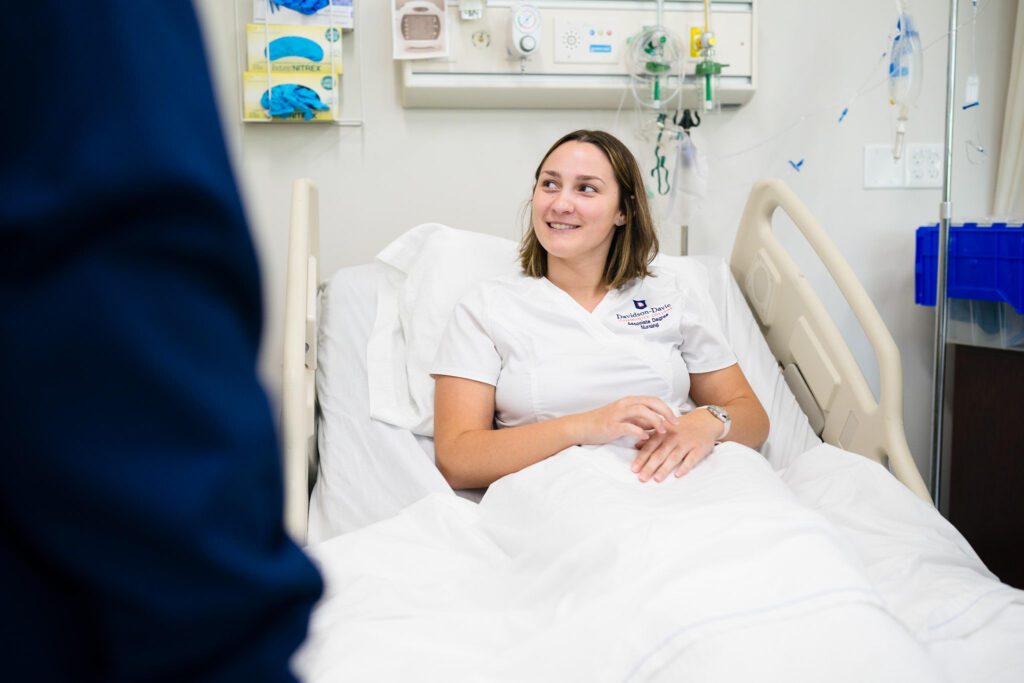

Recommendations
Highlighted throughout the case study are lessons learned by Davidson-Davie and Atrium Health Wake Forest Baptist when they launched the first registered nursing apprenticeship program in North Carolina. Below are recommendations for other colleges and health care partners to consider when scaling nursing apprenticeship programs across the state.
Adopt a holistic approach to nursing school admissions
A holistic approach to nursing admissions has been reported to “increase diversity across students without decreasing standardized scores and program GPA.” Nursing has lagged in this area, but some colleges are finding that by adopting a holistic admissions process, they have increased the diversity of their applicant pool.
In years past, nursing programs often used a weighted rubric to determine admissions, with more weight given to standardized tests. Davidson-Davie shifted to a more holistic admissions approach that considers other factors in addition to standardized test scores, including academic history, previous college degree, veteran or member of armed forces, former or current Career and College Promise student, and active medical certification.
By adopting a more holistic approach, colleges like Davidson-Davie have seen more diverse nursing cohorts and retained pass rates and overall program GPA. See Appendix F for Davidson-Davie’s admissions rubric.
Conduct focus groups
Data tracking – noting a student’s entry term, apprenticeship assignment, reason(s) for not completing, and employment placement after graduation – helps institutions and health care systems better understand the reach and success of the program. However, this data only tells a portion of a student’s journey.
Focus groups with current and former apprentices, including those who have stopped out of the program, can provide additional insight. Students can provide feedback on their apprenticeship experiences to leaders responsible for making program decisions and iterations.
In addition to being informative, focus groups allow space for students to express their ideas and have their voices heard with regards to their apprenticeship experiences.
Designate a nursing apprenticeship liaison
Like any model to advance educational access and talent supply, it takes dedicated individuals to own and implement the model.
While Davidson-Davie’s dean of health sciences, Dr. Holly Myers, has been a key individual to lead the efforts for the nursing apprenticeship program, all entities agree that a boots-on-the-ground liaison working between the two systems is needed.
The liaison model has worked within the state’s Career and College Promise program – a program that allows high school students to take college courses tuition free. To alleviate the registration and advising barriers, many community colleges hire liaisons to help high school students navigate their college experience. Additionally, those same liaisons serve as a key support person for the high school students enrolled in college courses.
Responsibilities for a nursing apprenticeship liaison could include tracking student progress, communicating between the academic institution and hospital systems, recruiting future apprentices, serving as a liaison for additional health care apprenticeships, and assisting the academic institution’s point person with administrative duties related to being an apprenticeship sponsor. If initial numbers cannot support a full-time position, consider a part-time position or shifting responsibilities of other team members to incorporate duties of an apprenticeship liaison.
Look for additional funds to offset apprenticeship costs
Despite the support at both the federal and state levels to expand and fund apprenticeships, much of that funding is off limits to health care systems due to their size and interest in adult apprentices.
Philanthropic and grant funding could offset costs for employers, students, and colleges by:
- Providing tuition funds for students who do not qualify for tuition reimbursements from their employer or are ineligible for federal and state scholarships.
- Providing financial support for apprentices’ once they move to part-time hours. These funds could cover transportation, child care assistance, and other expenses associated with college attendance.
- Paying the salary of a liaison.
- Investments for expansion of other health care apprenticeship programs.
Partner to boost salaries of nursing instructors
For years, the NCCCS has noted its inability to retain nursing instructors and other faculty in high-demand fields. While the recent 2023-24 budget included nursing faculty salary increases, it may not be enough to retain nursing faculty.
This is a nationwide problem. The nursing faculty vacancy rate across the country increased from 6.5% in 2020 to 8.8% in 2022. Without the ability to hire and retain nursing faculty, colleges are limited in the number of nursing students they can admit each year. The North Carolina Board of Nursing sets a 1:10 faculty-student ratio for clinical experiences.
One idea to help colleges pay the cost necessary to hire and retain nursing faculty is a split salary model with the health care partner. The late Dr. Darrin Hartness, former president of Davidson-Davie, suggested hospitals hire nursing directors and add a teaching requirement at the local community college. Both the community college and hospital system would split the cost of salary and benefits.
Craven Community College, Durham Technical Community College, Surry Community College, and Wayne Community College have launched similar models with health care partners. More community colleges are expected to follow.
Consider adding a pre-apprenticeship program for high school students
As rural areas continue to face population declines, one community college is on track for ‘growing their own health care professionals’ starting as early as high school. Surry Community College is the first North Carolina community college to introduce a nursing pre-apprenticeship model to its service area for high school students. This apprenticeship program is hosted through Surry-Yadkin Works.
Students complete NUR 111 as part of North Carolina’s Career and College Promise program and connect with participating employers to become pre-apprentice nurse aides while still in high school. In fall 2023, 60% of Surry Community College’s nursing cohort had participated in Surry-Yadkin Works.
Expand health care apprenticeships beyond nursing
Nursing apprenticeships are just one piece of the puzzle to help solve health care shortages. Just as important to decreasing nursing shortages is addressing the shortages among nurse aides, pharmacy technicians, paramedics, and more. As Davidson-Davie did, use the nursing apprenticeship model as a foundation to build additional health care apprenticeships with health care employers.
An apprenticeship model is a step in the right direction to mitigate the nursing shortages North Carolina is projected to see over the next 10 years. But meeting the demands of the health care workforce is multi-layered and will involve collaboration across multiple systems.
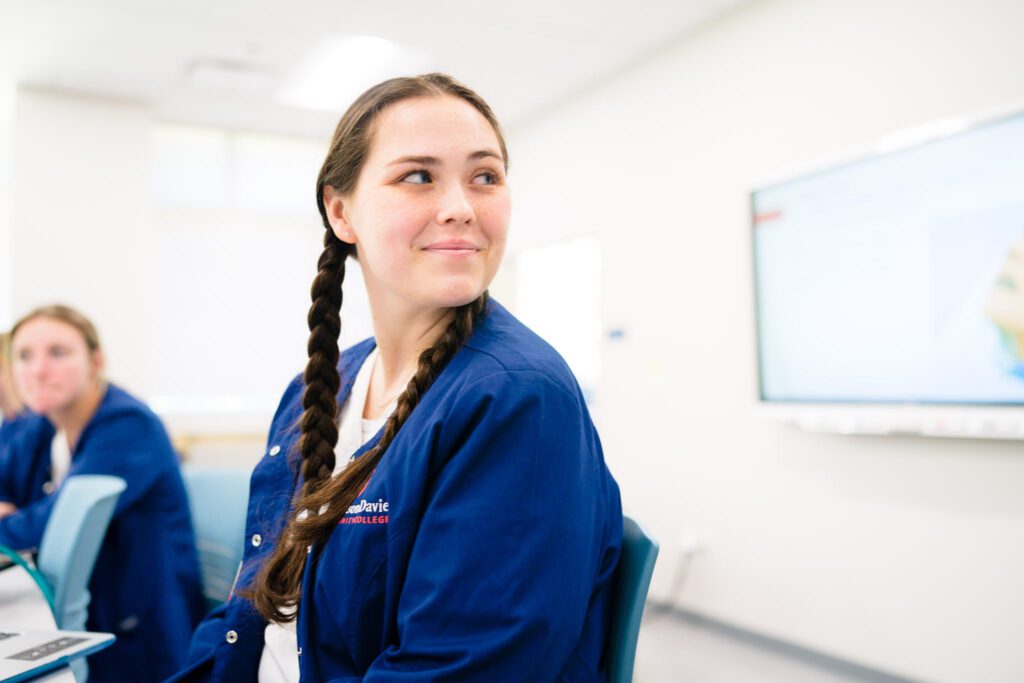

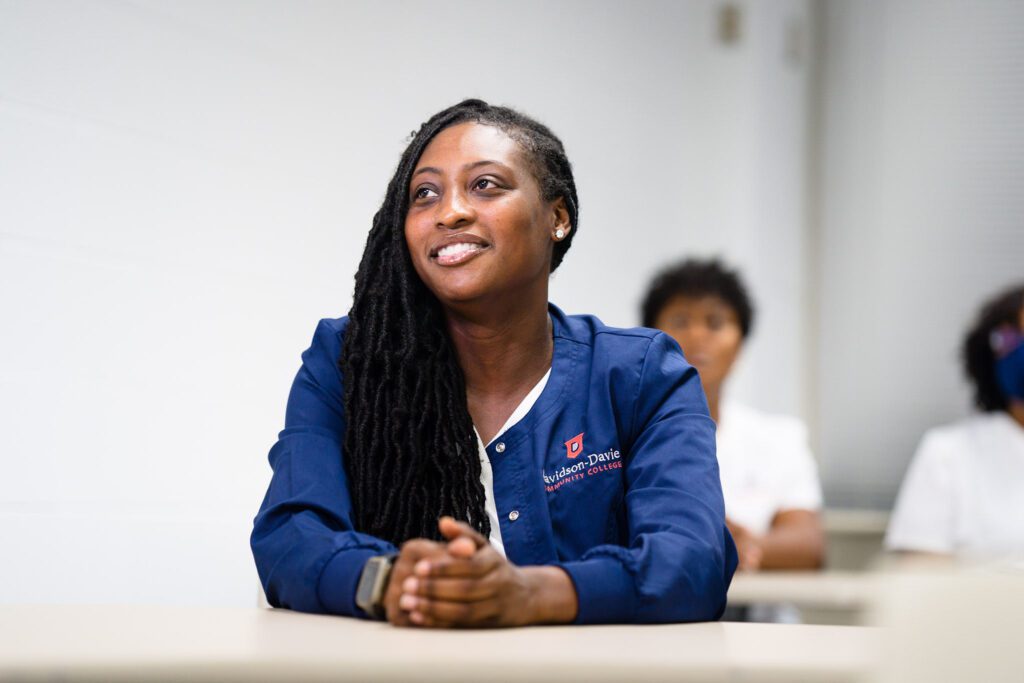

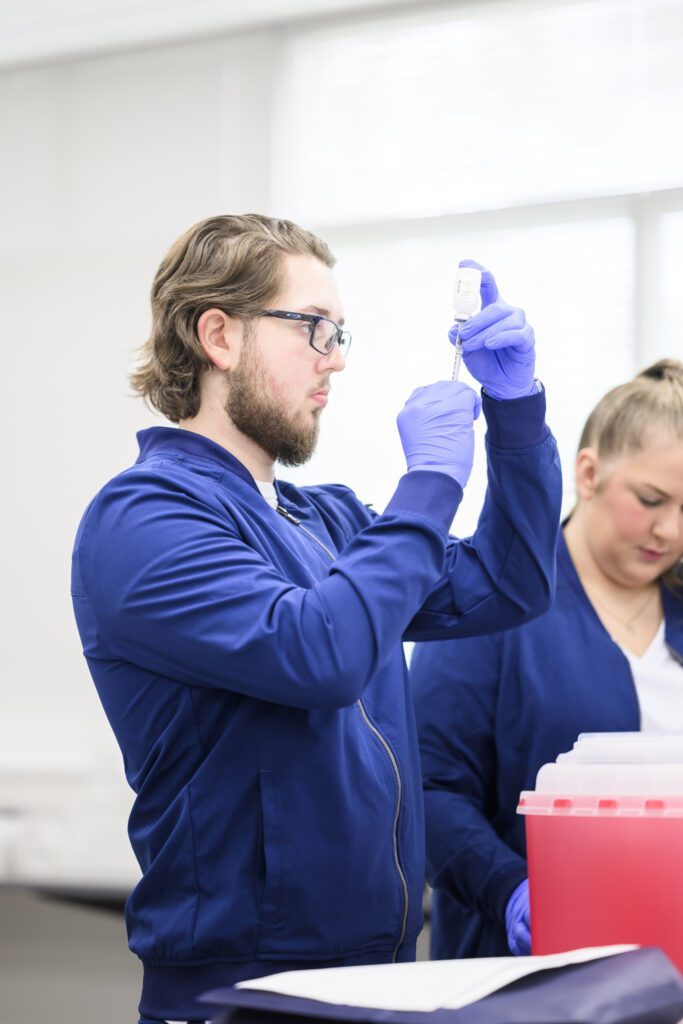

Appendices
Appendix A: Quick guide to launching a nursing apprenticeship program
Appendix B: Steps to registering an apprenticeship program with ApprenticeshipNC
Appendix C: Davidson-Davie’s ApprenticeshipNC program request form
Appendix D: Atrium Health Wake Forest Baptist apprenticeship documents
Appendix E: Davidson-Davie’s nursing degree packets
Appendix F: Holistic nursing admission rubric
Appendix G: Additional resources
- EdNC.org
- NC Community College System
- ApprenticeshipNC
- Davidson-Davie’s dean of health sciences contact information
For more information, please contact Emily Thomas ethomas@ednc.org.
Behind the Story
The nursing apprenticeship case study was informed by the following interviews:
- Davidson-Davie Community College representatives, including apprentices
- Atrium Health Wake Forest Baptist representatives
- ApprenticeshipNC representatives
Support for this case study was provided by the Blue Cross and Blue Shield of North Carolina Foundation as part of their commitment to profile and strengthen approaches to supporting the state’s health care workforce.
EdNC would like to extend a special thank you to Dr. Holly Myers, Davidson-Davie’s dean of health sciences, for her assistance with the development of resources and sample documents.
